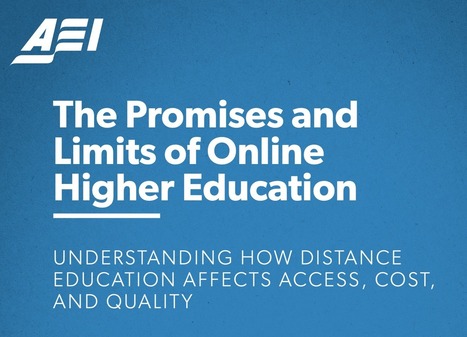New IPEDS data, new online ed profile with consistent but slowing trends
Get Started for FREE
Sign up with Facebook Sign up with X
I don't have a Facebook or a X account
 Your new post is loading... Your new post is loading...
 Your new post is loading... Your new post is loading...

ChristopherBell's curator insight,
May 14, 2015 10:47 PM
Awesome stuff to share with parents and graduating seniors! 
Carlos Godoy Rodríguez's curator insight,
May 15, 2015 1:13 PM
7 mitos y realidades sobre la formación online.
Mito nro. 1, no se puede obtener un empleo acreditando un diploma logrado mediante aprobación de cursos en línea. Reaalidad: 62% de los profesionales de RRHH creen que los diplomas obtenidos por cursos online son equivalentes o mejores que los logrados en universidades tradicionales.
Mito nro 2, sólo universidades de dudosa reputación ofrecen programas que se imparten totalmente en línea. Realidad: el porcentaje de instituciones que ofrecen programas completamente virtuales se ha duplicado en la última década hasta alcanzar 62.4%.
Mito nro. 3, los programas virtuales contribuyen con el aislamiento de sus estudiantes. Realidad: los cursos distribuídos en el formato presencial tradicional pueden también incentivar el aislamiento.
Mito nro. 4, obtener un diploma en línea es tomar el camino fácil. Realidad: si bien es cierto que el formato eLearning es más flexible, ello no significa que los cursos dictados en ésta modalidad sean menos rigurosos.
Mito nro. 5, "Tengo todo el tiempo del mundo para culminar mi curso online". Realidad: si intenta retrazar indefinidamente el cumplimiento de las tareas asignadas en un curso online, muy problamente, no superá ese curso. La procastinación no funciona el mundo real ni en el virtual.
Mito nro. 6, usted no aprenderá mucho tomando cursos vía eLearning. Realidad: investigaciones recientes indican que no hay diferencias significativas entre los resultados de aprendizaje por estudios virtuales y el método presencial tradicional.
Mito nro. 7, puedo hacer fraude en los programas de formación online. Realidad: muchas escuelas online han implementado sistemas de protección antifraude. Algunas otras exigen la realización de exámenes presenciales a sus alumnos. ¡ El gran hermano siempre está observando...! 
Ellen Comito McKeown's curator insight,
July 22, 2015 6:16 PM
A great, visual way to explain the value of online education.

Meryl van der Merwe's curator insight,
February 16, 2015 7:47 AM
I agree!! I first got into online teaching really tentatively about 2 years ago and now I love it. My physical classroom is so limited in comparison. My favorite thing is how I can give each student personal attention without ignoring the rest of the students. 
Sande Woodson's curator insight,
February 16, 2015 12:46 PM
Many good insights here... a positive attitude about online teaching, instead of a "less than" approach. ��

Rosemary Tyrrell, Ed.D.'s curator insight,
November 14, 2014 1:56 PM
Some useful resources here. Thanks, Shannon! 
Claire Brooks's curator insight,
November 14, 2014 6:31 PM
not a lot of new or cutting edge stuff here, but nevertheless a collection that might be useful

Enrico De Angelis's curator insight,
June 14, 2014 3:05 PM
an element of an interesting "knowledge base" |

Raquel Oliveira's curator insight,
March 19, 2015 5:29 PM
Genial a utilização da taxonomia de Bloom nesse infografico das possiveis atividades em formato "blended"(mix presencial e on line) 
Dr. Melissa A. Bordogna's curator insight,
March 26, 2015 1:59 AM
At a glance, I thought this a helpful infographic. It also made me think of the types of feedback I give my students. In addtion to using a rubric (marking criteria), I tend to provide a fair bit of written feedback. How about you...Which types of feedback have you found to be very effective in terms of student learning (as oppose to time-saving for us)? 
Karen Ellis's curator insight,
April 1, 2015 6:57 PM
Designing and planning assesment in online learning is very important. This infographic reminds us of the importance of making the task student centric and that ongoing feedback is critical.
|

























